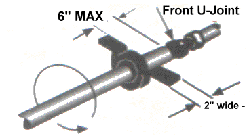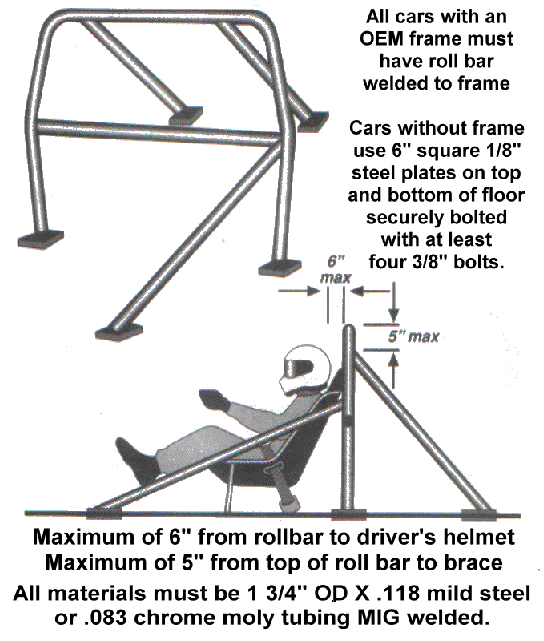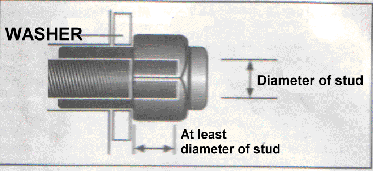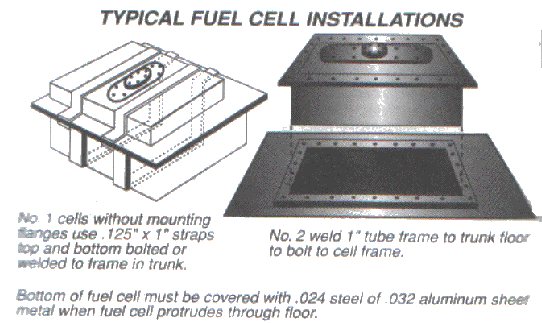Don's Guide to passing Tech Inspection
 Don's Tech Guide
Note: Some of the wording might not be exactly the same as either the
IHRA or NHRA Official Rule Books and our recommendations may exceed some
of the basic requirements for your class as required by NHRA or IHRA.
Rollbar / Cage
QUESTION: From our mailbox - Is a rollbar and a rollcage the same thing or is a rollbar just the hoop behind the driver?
ANSWER: A six or eight point rollbar is often described as a rollcage but in fact
only becomes a cage with the addition of the windshield and dash bars - see illustration below - for more info check the bar / cage rules lower on this page.
 Rollcages can vary from a 10 point - similar to the 12 point above but without the forward struts - to some funny car type tube chassis cages with dozens of attachment points.
FLYWHEEL / SCATTERSHIELD
QUESTION: From our mailbox - I plan to put a 4 speed in my Street Class race car. Do I need a scattershield to pass tech?
ANSWER: Not for your class. Rulebook says: 11.49 & quicker - SFI 6.1 Flywheel shield and SFI 1.1 clutch, pressure plate and flywheel are mandatory.
|
DRIVESHAFT LOOPS
QUESTION: From our mailbox - I have slicks on my car but it only goes 15 seconds for an ET. Do I need to have a driveshaft loop? What are the rules?
ANSWER: No Matter what the ET a loop is required if your car has slicks.
Rulebook says: 1/4"thick X 2"wide steel - must completely encircle the driveshaft
within 6 inches of the front U-joint and be attached to the floor with a minimum of
four 3/8" diameter bolts.
|
 |
We have seen some pretty odd looking things under cars but this is where
the WORST are. Biggest problem: Inadequate size / thickness of
material. Second biggest : WRONG LOCATION. Rulebook says: 1/4 X 2
inches Steel - must completely encircle the driveshaft within 6 inches
of the front U-joint. Any 9.99 sec car must have a second loop at the rear.
No Matter what the ET a loop is required if your car has slicks.
QUESTION: From our mailbox: What type of material do I need for a rollbar
and how is it attached to the car?
ANSWER: We have reprinted the complete IHRA rules on rollbar/cages
and have added the illustration below from the rulebook.
---------------------------------------------------

ROLL BARS{reprint from IHRA Rulebook}
Mandatory in all cars running 11.49 or quicker, or per class
requirements. All roll bars must be within 6 inches of the rear or
side of the driver's head, extend in height at least 3 inches above
the driver's helmet with driver in normal driving position, and be at
least as wide as the driver's shoulders or within 1 inch of the
driver's door. Rollbar must be adequately supported or cross-braced
to prevent forward or lateral collapse. Rear braces must be
of the same diameter and wall thickness as the roll bar and
intersect with the roll bar at a point not more than 5 inches from
the top of the roll bar. Sidebar must be included on driver's side
and must pass the driver at a point midway between the shoulder
and elbow. Swing-out sidebar permitted. All roll bars must have in
their construction a cross bar for seat bracing and as the shoulder-
harness attachment point; cross bar must be installed no more
than 4 inches below, and not above, the driver's shoulders or to
side bar. All vehicles with OEM frame (i.e. pickup truck where body
bolts to framerails) must have roll bar welded or bolted to frame.
Installation of frame connectors on unibody cars does not
constitute a frame; therefore, it is not necessary to have the roll bar
attached to the frame. Unibody cars with stock floor and firewall
(wheeltubs permitted) may attach roll bar with 6-inch x 6-inch x
.125-inch steel plates on top and bottom of floor bolted together
with at least four 3/8-inch bolts and nuts, or weld main hoop to
rocker sill area with .125-inch reinforcing plates, with plates welded
completely. All 4130 chrome moly tube welding must be done by
approved TIG heliarc process; mild steel welding must be done by
approved MIG wire feed or approved TIG heliarc process. Welding
must be free of slag and porosity. Any grinding of welds prohibited.
Roll bar must be padded anywhere driver's helmet
may contact it while in driving position. Adequate padding must
have minimum 1/4-inch compression or meet SFI Spec 45.1.
ROLL CAGE{reprint}
Mandatory in all cars running quicker than 10.99 seconds or faster
than 135 mph, or per class requirements. Cars with unaltered
firewall, floor and body (from firewall rearward, wheeltubs
permitted) running between 10.00 and 10.99, roll bar permitted in
place of roll cage, or per Class Requirements. Cars with altered
firewall, floor faster than 11.49 must have rollcage and window net.
All cage structures must be designed in an attempt to protect the
driver from any angle, 360 degrees. All 4130 chrome-moly tube
welding must be done by approved TIG heliarc process; mild steel
tube welding must be approved MIG wire feed or TIG heliarc
process. Welding must be free of slag and porosity. Any grinding of
welds prohibited. Additionally, roll cage must be padded anywhere
the driver's helmet may contact it while in the driving position.
With driver in driving position, helmet must be in front of main
hoop. If helmet is behind or under main hoop, additional tubing,
same size and thickness as roll cage, must be added to protect
driver. Main hoop may be laid back or forward, but driver must be
encapsulated within the required roll cage components. On
unibody cars with stock floor and firewall (wheel tubs permitted),
the roll cage may be bolted or welded to the floor/rocker box via 6-
inch x 6-inch x .125-inch steel plates
Unless attaching to OEM floor or frame, the minimum requirements for a
frame member to which a roll cage member is attached are 1 5/8-
inch x .118-inch MS or .083-inch CM round and/or 2-inch x 2-inch
x .058 MS or CM rectangular.
All cage structures must have in their construction a cross bar for
seat bracing and as the shoulder-harness attachment point; cross
bar must be installed no more than 4 inches below, and not above,
the driver's shoulders, or to side bar. All required rear braces must
be installed at a minimum angle of 30 degrees from vertical and
must be welded in. Side bar must pass the driver at a point midway
between the shoulder and elbow.
Unless an OEM framerail is located below and outside of driver's
legs, a rocker or sill bar, minimum 1 5/8-inch x .083 CM or .118 MS
or 2-inch x 2-inch x .058-inch CM or MS rectangular, is mandatory
in any car with a modified floor or rocker box within the roll-cage
uprights (excluding 6 square feet of transmission maintenance
opening). Rocker bar must be installed below and outside of
driver's legs and must tie into the main hoop, the forward hoop,
frame, frame extension, or side diagonal. Rocker bar may not tie
into swing-out side bar support. If rocker bar ties into side diagonal
more than 5 inches (edge to edge) from forward roll-cage support
or main hoop, a 1 5/8-inch x .083 CM or .118 MS brace/gusset is
mandatory between the diagonal and forward roll-cage support or
main hoop.
---------------------------------------------------
QUESTION: George H asked: What are the rules on wheel studs?
ANSWER: All wheel studs must project through the wheel both front
and rear when recessed aftermarket nuts are used. all wheel studs must project through lug nut when
stock nut is used. (illustration below)

---------------------------------------------------
QUESTION: L. B. wrote: I am considering putting a car
in the street class. What should I be made aware of before I go too
far? Is there anything special that has to be done to the car before I put it on the track? Am I allowed to remove any of the interior for weight reduction?
ANSWER: Other than the general rules posted on this page like
battery and driveshaft loop and neutral safety switch, etc., there are not
a lot of interior rules that apply to the street class. You may remove weight
from the interior so long as it does not compromise the safety of the vehicle or expose the drivers compartment to fumes from the engine or
trunk if a battery or fuel cell is located there. If the stock drivers seat and belts and mounts are not modified in any way you are OK as well.
---------------------------------------------------
QUESTION: Terry B asked: What are the rules on Fuel Systems
plumbing? Where do I run my lines? How do I mount my gas tank?
ANSWER: That's a lot of questions. Here we go with another reprint.
COMPLETE IHRA Fuel System rules {reprint}
Location: All fuel tanks, lines, pumps, valves, etc. must be
outside of the driver's compartment and within the confines of the frame
and/or steel body. Cool cans, fuel-distribution blocks, etc. must be located
at least 6 inches forward of the flywheel/bellhousing area on rear-wheel-
drive (RWD) cars, and on opposite side of flywheel/bellhousing area on
front-wheel-drive (FWD) cars. Fuel-pressure-gauge isolators, with steel-
braided line, may be mounted on firewall.

Tanks: When permitted by class regulations, fuel tanks located outside
body and/or frame must be enclosed in a steel tube frame constructed
of minimum 1 1/4-inch O.D. x .065 chrome moly or .118 mild-steel tubing.
All fuel tanks must be isolated from the driver's compartment by a firewall,
completely sealed to prevent any fuel from entering the driver's
compartment. All fuel tanks must have a pressure cap and be vented
outside of car body. A positive-locking screw on fuel-tank cap is
mandatory on all cars. Insulated fuel tanks prohibited. When used, fuel
cells must have a metal box protecting the part of the fuel cell that is
outside of body lines or trunk floor, excluding hose-connection area in
rear. Non-metallic fuel cells or tanks must be grounded to frame.
Lines: All non-OEM fuel lines (including gauge and/or data-recorder
lines) must be metallic, steel-braided or IHRA-accepted "woven or woven-
pushlock." A maximum of 12 inches total (front to rear) of non-metallic or
non-steel-braided hose is permitted for connection purposes only;
individual injector-nozzle fuel lines are excluded. Fuel lines (except steel-
braided lines) in the flywheel/bellhousing area must be enclosed in a 16-
inch length of steel tubing, 1/8-inch minimum wall thickness, securely
mounted as a protection against fuel-line rupture. Fuel lines may not be
routed in the driveshaft tunnel. IHRA-accepted woven or woven-pushlock
fuel lines: Aeroquip FC300, FC332; Aeroquip Star Lite 200; AQP; Earl's
Prolite; Gates LOL Plus; Goodridge 710; RussellTwist-Loc 836 and XRP
HS-79.
-------------------------------------------------
Question: John R. asked: Can I race my car without a hood?
Answer: We got asked this question a few times. Rulebook says:
FLASH SHIELDS
Carburetor/injector inlet must not be openly exposed. In lieu of
hood, carburetors/injectors must be equipped with a flash shield or
velocity stacks that cover the top, back, and sides, preventing fuel
from being siphoned into the airstream or blown into driver's face.
Additionally, any car that is driven, not towed, through the pits with
open stack(s) not protected by hood or scoop must have screening
installed on open stack(s) to prevent items from entering stack.
----------------------------------------------------
Question: Bruce J asked: I see people putting sandbags in their trunk
to help them get a little more traction. Is this legal?
Answer: Just throwing them in the trunk is not legal. Rulebook says:
As permitted in Class Requirements. Any material used for the purpose of
adding to a car's total weight must be permanently attached to the
car's structure and must not extend in front of or behind the rear of the
car's body or above the rear tires. No liquid or loose ballast permitted
(i.e. water, sandbags, rocks, shot bags, metal weights, etc.). Weight boxes
(2 maximum) made of 1/8-inch material may be constructed to hold small
items such as shot bags, lead bars, etc., as long as box and contents do
not weigh more than 100 pounds or as outlined in class requirements. The
box must be securely fastened to the frame or crossmember with at least
two 1/2-inch-diameter steel bolts. Any liquid other than engine fuel being
used, located behind the front firewall (on a front-engine car), is
considered ballast and is prohibited, except for intercooler tanks that contain water and/or ice only. Tank must be SFI spec 28.1 fuel cell of
maximum 3 gallons capacity. Must be securely mounted to frame, frame
member or OEM floorpan. Removable weight must be securely mounted
to the frame or frame structure by a minimum of two 1/2-inch-diameter
steel bolts per 100 pounds or one 3/8-inch bolt per 5 pounds. Hose
clamps, wire, strapping, tape, tie wraps, etc. for securing weight or ballast
prohibited. Maximum amount of removable and/or permanent ballast,
unless otherwise stated under Class Requirements, is 300pounds.
---------------------------------------------------
Roll bar / Rollcage RULES
We have contacted the IHRA Tech Director for a clarification
on the altered floor / firewall rule with regard to the ET where
this rule applies. He has informed us that if a floor or firewall
is altered in an 11.49 or quicker car it requires a rollcage - not
a 6 or 8 point rollbar. Upgrade kits are available for a reasonable
price from most chassis manufacturers so cost is not a concern.
**11.49 and quicker: IF YOU HAVE ALTERED YOUR FLOOR
OR FIREWALL - A FULL CAGE IS REQUIRED WITH WINDOW NET.
**Belt Date Codes apply to any vehicle quicker than 11.49
---------------------------------------------------
BATTERIES: The biggest problem
All batteries must be securely mounted. Batteries may not be
relocated into the driver or passenger compartments. Rear firewall
of .024-inch steel or .032-inch aluminum (including package tray)
required when battery is relocated in trunk. In lieu of rear firewall,
battery may be located in a sealed .024-inch-steel, .032-inch-aluminum,
or NHRA-accepted poly box. If sealed box is used in
lieu of rear firewall, box may not be used to secure battery and
must be vented outside of body. Relocated battery(s) must be
fastened to frame or frame structure with a minimum of two 3/8-
inch-diameter bolts. ("J" hooks prohibited or must have open end
welded shut.) Metal battery hold-down straps mandatory.
Strapping tape or Electrical zip ties prohibited. Stock unaltered battery
boxes / trays with OEM hold downs permitted only in stock location.
---------------------------------------------------
NEUTRAL SAFETY SWITCH
Most failures we have observed at Tech are here. Thankfully, it's usually
a pretty easy fix but a non - functioning neutral safety switch is a very
dangerous thing.
TRANSMISSION, Automatic {reprint}
Any non-OEM automatic floor-mounted automatic-transmission
shifter must be equipped with a spring-loaded positive reverse
lockout device to prevent the shifter from accidentally being put
into reverse gear. Functional neutral safety switch mandatory. All
transmission lines must be metallic or high-pressure-type hose. All
vehicles running quicker than 10.99 seconds or faster than 135
mph and using an automatic transmission must be equipped with a
transmission shield meeting SFI spec 4.1 and labeled accordingly.
(Blanket-type shield, appropriately labeled as meeting SFI spec
4.1, permitted.) All non-blanket-type shields must incorporate two
(or one, per manufacturer's instructions) 3/4" x 1/8" straps that bolt to
the shield on each side and pass under the transmission pan, or
transmission pan must be labeled as meeting SFI spec 4.1.
Permitted in all classes where an automatic transmission is used.
All vehicles running quicker than 9.99 seconds or faster than 135
mph and using an automatic transmission must be equipped with a
flexplate meeting SFI spec 29.1 and covered by a flexplate shield
meeting SFI spec 30.1.
PIT SPACE SAFETY
No work is to be done under a vehicle unless it is supported by Jack
stands. Either driver or crewman must be seated in the vehicle if it
is running [ setting timing, etc.] in the pit space. Any vehicle
with limited rearward visibility should have a crew member to guide
the driver out of his pit space. REMEMBER - Speed Limit is FIVE MPH in
the pits and on the return road once you pass the timeslip booth. Rulebook
says: It is mandatory that a driver be seated in the car in the normal driving
position anytime the engine is running, unless coupler or driveline is
removed from vehicle. The practice of transbrake testing, converter stalls,
line-loc testing, and/or transmission warming is prohibited in all classes,
in all areas of the event except in starting line approach areas beyond
staging, or unless vehicle is on jackstands. Non-compliance is grounds
for disqualification.{reprint}
FIRE EXTINGUISHERS
Fire Extinguishers are required in all Super / Pro entries and are
recommended in all cars. Don't be without one. If your car catches fire
at the far end of the track you're a minute or two away from the Track
Safety Truck - that could be too long. The Tech committee may soon
require ALL cars to have one - so be prepared.
COOLING SYSTEM{reprint}
All cooling systems/radiators must be installed in the stock location
for body style used. Cooling system must include an overflow:
minimum capacity 1 pint. Overflow tank/container must be securely
attached; no tie wraps, duct tape, etc.
BRAKES{reprint}
Brakes on each car, regardless of class, must be in good working
order with four-wheel hydraulic brakes as a minimum requirement.
Lightening of backing plates, brake drums, and/or brake shoes by
cutting or trimming metal prohibited. Cooling or lightening holes
may not be drilled in cast-iron disc-brake rotors. Brake lines must
be steel, steel-braided, or DOT-approved flexible and routed outside
the framerail, or enclosed in a 16-inch length of 1/8-inch-minimum-
wall-thickness steel tubing securely mounted where line(s) pass the
flywheel bellhousing area and not routed in the driveline tunnel. All
brake lines must be attached to chassis as per OEM style; hoses must
have mounting brackets; no tie wraps, tape, etc. All brake lines on any
rear-engine car must be protected inside of tubing or be of braided-steel
construction where they pass the engine. All pedals must be covered
with non-skid material. Automated and/or secondary braking systems
prohibited. Application and release of brakes must be a direct function of
the driver; electronics, pneumatics, or any other device may in no way
affect or assist brake operation. All line-locs (electric or hydraulic)
must be self-returning to normal brake operating mode.
RULE BOOK
C.B.D.R.A. Tech Inspectors use the IHRA rule book.
to inspect your vehicle on raceday. If you are building or buying a
Racecar get a rule book first. There's nothing worse than spending
a whole winter building a car and then failing TECH at the first race.
Safety Equipment requirements are determined by your ET - The faster
you go the more you need. [See below] For rule books try your local Speed shop
ALL CLASSES - Driveshaft loop MANDATORY with slicks - seat
belts - D.O.T. / SNELL Helmet - Neutral Safety switch
11.49 - SFI Scattershield for Standards - Fire Extinguisher - Rollbar
10.99 - Rollcage - SFI 4.1 Trans Shield - SFI 18-1 Harmonic Balancer
Aftermarket Axles - SFI 3.2A/1 Jacket
9.99 - SFI 29.1 Flexplate and SFI 30.1 Shield - Rear Driveshaft Loop
SFI 3.2A/5 Clothing and Neck Collar - Parachute [ over 150 MPH ]
8.99 - Chassis Certification Required by IHRA / NHRA
TECHNICAL INSPECTION WAIVER
Prior to competition (including private test sessions), all cars and
driver equipment must undergo a technical inspection, or have
been inspected under the Extended Technical Inspection program.
However, IHRA and its member tracks make no representations,
warranties or assurances that a technical inspection, including the
review of any written information will; 1) Detect every problem with
a car or a driver's personal equipment or clothing; 2) Detect every
problem with rule compliance, or; 3) Prevent injury, death or
property damage. The participant agrees that participant bears the
ultimate responsibility at all times to ensure the safety of
participant's vehicle and to ensure that participant complies with all
applicable IHRA rules. The participant agrees that participant is in
the best position to know about the construction and operation of
participant's vehicle, equipment and clothing, and whether there
has been compliance with all applicable IHRA rules.
-------------------------------------------------------

